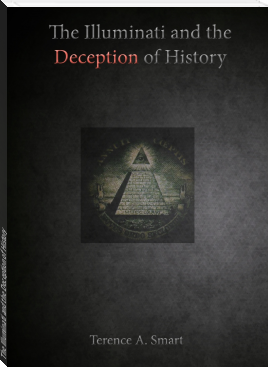The Truth about Germany and the World Wars by Terence Smart (small books to read txt) 📕

- Author: Terence Smart
Book online «The Truth about Germany and the World Wars by Terence Smart (small books to read txt) 📕». Author Terence Smart
The crux of this matter is that the Jews have been getting away with presenting a grossly distorted version of history to us, a version in which they are the completely innocent victims, and the Germans are the bad guys who have been persecuting the poor Jews for no reason at all. They've been pumping out this propaganda for 70 years and they've been getting away with giving us a falsified version of history.
Again you will not hear of the following information on the Jewish controlled T.V networks. German civilians were incarcerated into concentration camps weeks after the war had ended.
The Allies, (mainly the Russian’s) continued to operate many formerly German concentration camps after World War II. Additional camps to intern Germans were established in Poland, Czechoslovakia, Hungary, Romania and Yugoslavia. While the population of the German concentration-camp system had grown to a record peak of 700,000 by the beginning of 1945, the number of Germans incarcerated across Europe in similar camps by the end of 1945 was possibly even higher.
The German concentration camps at Buchenwald, Sachsenhausen, Mühlberg, Fürstenwalde, Liebe-Roze, Bautzen and other locations were taken over by the Russian Gulag Archipelago. The camp at Buchenwald, for example, was operated by the Soviet Union until 1950. Conditions at the camps under Soviet control were atrocious.
One former inmate described his five years in the Soviet-run Buchenwald Camp:
“People were mere numbers. Their dignity was consciously trampled upon. They were starved without mercy and consumed by tuberculosis until they were skeletons. The annihilation process, which had been well tested over decades, was systematic. The cries and groans of those in pain still echo in my ears whenever the past comes back to me in sleepless nights. We had to watch helplessly as people perished according to plan—like creatures sacrificed to annihilation”.
While no one can know the exact number of inmates and deaths at Buchenwald, it is reasonably certain a higher percentage of inmates died under Soviet control than under German control. Viktor Suvorov estimates that 28,000 people were imprisoned by the Soviets at Buchenwald from 1945-1950, of whom some sources estimate that at least 13,000 (48%) and as many as 21,000 (80%) Germans died in Soviet-run Buchenwald. By comparison, it is estimated that 250,000 people were imprisoned by the Germans at Buchenwald from 1937 to 1945. Of that number a detailed June 1945 U.S. government report on German-run Buchenwald put the total deaths at 33,462 (13%).
The Soviet-run Buchenwald had a higher estimated death rate than the German-run Buchenwald.
Russian estimates show a total of 122,671 Germans passed through Soviet-run camps in the Soviet Zone after the end of the war. Of this total, 42,889 Germans died, or approximately 35%. The official Soviet statistics probably underestimate the true number of dead in the Soviet-run camps. American military intelligence units and Social Democratic Party groups in the late 1940s and 1950s estimate that a much higher total of 240,000 German prisoners passed through Soviet-run camps. Of these, an estimated 95,643 died, or almost 40%.
Many of the Germans in Poland were also sent to former German concentration camps. In March 1945, the Polish military command declared that the entire German people shared the blame for starting World War II. Over 105,000 Germans were sent to labor camps in Poland before their expulsion from Poland. The Polish authorities soon converted concentration camps such as Auschwitz-Birkenau and others into internment and labor camps. In fact, the liberation of the last Jewish inmates at the Auschwitz main camp and the arrival of the first ethnic Germans to Auschwitz were separated by less than two weeks. When the camps in Poland were finally closed, it is estimated that as many as 50% of the German inmates, mostly women and children, had died from ill-treatment, malnutrition and diseases.
Lamsdorf in Upper Silesia was initially built by Germany to house Allied prisoners of war. This camp’s postwar population of 8,064 Germans was decimated through starvation, disease, hard labor and physical mistreatment. A surviving German doctor at Lamsdorf recorded the deaths of 6,488 German inmates in the camp after the war, including 628 children.
A man named Günther Wollny, who had the misfortune of being an inmate in both Auschwitz and Zgoda, later stated, “I’d rather be 10 years in a German camp than one day in a Polish one.”
The sexual humiliation of female prisoners in the Polish camp at Potulice and the Theresienstadt concentration camp in Czechoslovakia had become an institutional practice by the end of 1945. Many of the women were sexually abused and beaten, and some of the punishments resulted in horrific injuries. The sexual exploitation of women in Polish-run camps contrasts to the experience of women in German-run concentration camps. Rape or other forms of sexual mistreatment was an extremely rare occurrence at German concentration camps, and severely punished by the authorities if detected.
After the war, the ICRC (Red Cross) reported that the sexual abuse of female inmates in Czech-run camps was pervasive and systematic. A foreign observer of one Czech camp noted that the German women were “treated like animals”. Russian and Czech soldiers come in search of German women for sexual purposes. Conditions there for women are definitely more unfavourable than in the German concentration camps, where cases of rape were rare.
The International Committee of the Red Cross (ICRC) attempted to send a delegation to investigate the atrocities reported in the Polish camps. It was not until July 17, 1947, when most Germans had either died or had been expelled from the camps, that ICRC officials were finally allowed to inspect a Polish camp.
Jewish journalist John Sack has confirmed the torture, murder and sexual assaults of German prisoners in post-war Polish camps operated by the Office of State Security. Most of the camps were staffed and run by Jews, with help from Poles, Czechs, Russians and concentration-camp survivors. Virtually all of the personnel at these camps were eager to take revenge on the defeated Germans. In three years after the war, Sack estimates that from 60,000 to 80,000 Germans died in the Office’s camps.
Jews that ran the camps were Shlomo Morel, Barek Einstein, Jacob Berman, Shlomo Singer and Chaim Studniberg.
Dwight Eisenhower was a war criminal of epic proportions. His policy killed more Germans in peace than were killed after D-Day in war. After Germany had surrendered the Americans were faced with having 5 million German prisoners. These German soldiers were herded into 30 separate camps. In these camps there were no tents, buildings, cooking facilities, water, toilets, or food. It was just a massive open field with barbwire fences around it. The prisoners had to sleep in the open and some of them would dig holes in the ground to sleep in. It is known, that the Allies had sufficient stockpiles of food and medicine to care for these German soldiers. This was deliberately and intentionally denied them. Many men died of gangrene from frostbite due to deliberate exposure. Local German people who offered these men food, were sent away on Eisenhower’s command. General Patton's Third Army was the only command in Europe to release a significant numbers of Germans.
To allow Eisenhower to get away with this mass murder he changed the designation of the prisoners from "Prisoners of War" (P.O.W.), required by the Geneva Convention to be fed the same rations as American G.I.'s, to "Disarmed Enemy Forces" (D.E.F.).
George Weiss was a German tank repairman and he said ‘"All night we had to sit up jammed against each other. But the lack of water was the worst thing of all. For three and a half days, we had no water at all. We would drink our own urine". Two colonels in the U.S. Army Medical Corps, James Mason and Charles Beasley described the conditions in one of the camps "Huddled close together for warmth, behind the barbed wire was a most awesome sight, nearly 100,000 haggard, apathetic, dirty, gaunt, blank-staring med clad in dirty field grey uniforms, and standing ankle-deep in mud and the men had not eaten for at least two days, and the provisions of water was a major problem”. General Eisenhower refused to let the Red Cross into the camps to give out provisions and this was against the Geneva Convention. It is estimated that up to 1.7 million of these German prisoners of war died of starvation and disease. It was nothing more than mass murder. Had the Germans done this to the Allied prisoners then we would have heard about it in movies and documentaries but because it was done by the Americans against the Germans not many people know about it. In fact if the Germans had done this to the Allies there would have been a movie made about it. After the German surrender was signed shouldn’t the German prisoners of war just be then freed and allowed to go home just like the Allied prisoners of war were.
Former American WW2 soldier Martin Brech was with the Company C, 14th Infantry Regiment, during his seventeen-month stay in Germany and he states:
“In late March or early April 1945, I was sent to guard a POW camp near Andernach along the Rhine. I had four





Comments (0)